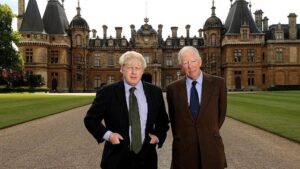The Secret Broker: Bill Gates, BHP and a goblin walk into a bar…

Picture: Getty Images
After 35 years of stockbroking for some of the biggest houses and investors in Australia and the UK, the Secret Broker is regaling Stockhead readers with his colourful war stories — from the trading floor to the dealer’s desk.
Bill Gates, BHP and a Goblin walk into a bar? This is not a joke though, as Bill Gates, BHP and a German goblin named kobold have actually come together to search the earth for mineral rich plays.
In the 16th century in Germany, superstitious miners believed that the underground mines that they were working in always had a kobold living in them who would haunt and taunt them.
Some believed that, just like humans live on Earth, kobolds are beings that actually live in rock itself.
They also believed that if they heard an underground knocking noise in the distance, not to go that way, as the kobold was warning them of danger.
Goblins in the machine
So how did the cardigan-wearing billionaire and an Australian mining giant end up getting into bed with a goblin?
Well, it goes back a few years, when Bill Gates was approached to become an investor in a company that intended to use artificial intelligence (AI) as a way to discover new mines which contain crucial minerals.
Being the geek that he is, he put in some loose change and ignored the fact that he was now associated with a goblin called Kobold, as that was the chosen name of said company.
KoBold Metals, the company, is Silicon Valley-based and has raised over U$192m in its quest to use AI and machine learning to sift through millions of bits of historical (and new) information relating to past mining activities.
Once the computer reels have stopped spinning and a printout appears, they then go into action using modern activities to back up their computer’s findings.
If they like what they see, they acquire the mining rights and joint venture it with one of their mining partners. One of those happens to be BHP.
So Bill stumps up some cash, the goblin goes about its business and BHP gets to JV with them, which is a good thing all round and especially good for BHP.
For you see, BHP paid out over US$15bn in dividends last year, but only spent US$75m on actually exploring for new mines.
In Bill’s world you have Moore’s Law which claims the number of transistors on a microchip doubles every two years. It’s a “pace of change” indicator thing for spocks.
But in the pharmaceutical world you have the opposite – it’s called Eroom’s Law, and it happens because the rising price of bringing a new drug to market stymies development.
Eroom’s Law can also be applied to mining. According to KoBold’s pitch, in the last 30 years the number of discoveries per dollar of exploration capital spent has declined by six times.
This means under Eroom’s Law that even if BHP were to expand its US$75m exploration budget sixfold, they are going to find potential mines at the same rate as they found them in 1990.
A good example of the goblin in action is when the computer spat out some information about a situation in the French province of Quebec. It successfully picked an area packed with valuable minerals which under conventional methods would have been classed ‘non prospective’.
So using AI and machine learning, they are currently sifting through more than 200 million pieces of written historical information on global mining situations, which are in the public domain and date back hundreds of years.
Anyone who has ever looked at the amount of information that can be found on the historical goldfields of Victoria knows it would take a human a lifetime to put it all together. KoBold can put the jigsaw puzzle pieces together in days.
Going back to their findings in Quebec, once the goblin had told them where to look, KoBold took 830 rock samples over an area of 142km and spent 12 weeks flying a giant metal detector over the same area.
It was attached to a helicopter and could send down electronic pulses that penetrated the Earth to some 500m deep. They then bought the mining rights to the area.
The next step was to JV it out on a royalty payment agreement, and when that happens, presto! – KoBold’s a digital disrupter in the mining space.
Hey there, Mr Blue Sky
As one early investor pointed out, lithium, nickel, cobalt and copper are not very rare.
In fact, cobalt is as common as tin but before companies like Tesla came to the forefront, the demand was never there and because of that, no money was spent exploring for it.
Hence the rush now and the subsequent boom in Australian small mining stocks, which we are all observing.
A word of warning though, even armed with all their data, computers and giant metal detectors, KoBold only expects to have a 20% success rate of finding a mineable deposit.
Just bear this in mind when a frothy exploration stock is still only at the ‘blue sky’ stage and running ahead of itself.
Though if your wife ever finds you talking mining stocks to a toadstool at the end of the garden, just tell her that you’re getting better advice than her financial planner.
The Secret Broker can be found on Twitter here @SecretBrokerAU or on email at [email protected].
Feel free to contact him with your best stock tips and ideas.
UNLOCK INSIGHTS
Discover the untold stories of emerging ASX stocks.
Daily news and expert analysis, it's free to subscribe.
By proceeding, you confirm you understand that we handle personal information in accordance with our Privacy Policy.








